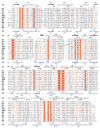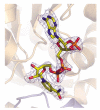Crystal structures of delta1-pyrroline-5-carboxylate reductase from human pathogens Neisseria meningitides and Streptococcus pyogenes
- PMID: 16233902
- PMCID: PMC2792033
- DOI: 10.1016/j.jmb.2005.08.036
Crystal structures of delta1-pyrroline-5-carboxylate reductase from human pathogens Neisseria meningitides and Streptococcus pyogenes
Erratum in
- J Mol Biol. 2006 Mar 31;357(3):1050
Abstract
L-proline is an amino acid that plays an important role in proteins uniquely contributing to protein folding, structure, and stability, and this amino acid serves as a sequence-recognition motif. Proline biosynthesis can occur via two pathways, one from glutamate and the other from arginine. In both pathways, the last step of biosynthesis, the conversion of delta1-pyrroline-5-carboxylate (P5C) to L-proline, is catalyzed by delta1-pyrroline-5-carboxylate reductase (P5CR) using NAD(P)H as a cofactor. We have determined the first crystal structure of P5CR from two human pathogens, Neisseria meningitides and Streptococcus pyogenes, at 2.0 angstroms and 2.15 angstroms resolution, respectively. The catalytic unit of P5CR is a dimer composed of two domains, but the biological unit seems to be species-specific. The N-terminal domain of P5CR is an alpha/beta/alpha sandwich, a Rossmann fold. The C-terminal dimerization domain is rich in alpha-helices and shows domain swapping. Comparison of the native structure of P5CR to structures complexed with L-proline and NADP+ in two quite different primary sequence backgrounds provides unique information about key functional features: the active site and the catalytic mechanism. The inhibitory L-proline has been observed in the crystal structure.
Figures










Similar articles
-
Crystal structure of human pyrroline-5-carboxylate reductase.J Mol Biol. 2006 Jun 23;359(5):1364-77. doi: 10.1016/j.jmb.2006.04.053. Epub 2006 May 11. J Mol Biol. 2006. PMID: 16730026
-
Purification, characterization, and crystallization of human pyrroline-5-carboxylate reductase.Protein Expr Purif. 2006 Sep;49(1):83-7. doi: 10.1016/j.pep.2006.02.019. Epub 2006 Mar 20. Protein Expr Purif. 2006. PMID: 16600630
-
Crystal structures of Delta1-piperideine-2-carboxylate/Delta1-pyrroline-2-carboxylate reductase belonging to a new family of NAD(P)H-dependent oxidoreductases: conformational change, substrate recognition, and stereochemistry of the reaction.J Biol Chem. 2005 Dec 9;280(49):40875-84. doi: 10.1074/jbc.M507399200. Epub 2005 Sep 28. J Biol Chem. 2005. PMID: 16192274
-
Isozymes of P5C reductase (PYCR) in human diseases: focus on cancer.Amino Acids. 2021 Dec;53(12):1835-1840. doi: 10.1007/s00726-021-03048-x. Epub 2021 Jul 22. Amino Acids. 2021. PMID: 34291342 Review.
-
Evolution of proline biosynthesis: enzymology, bioinformatics, genetics, and transcriptional regulation.Biol Rev Camb Philos Soc. 2015 Nov;90(4):1065-99. doi: 10.1111/brv.12146. Epub 2014 Nov 4. Biol Rev Camb Philos Soc. 2015. PMID: 25367752 Review.
Cited by
-
Structural and functional characterization of microcin C resistance peptidase MccF from Bacillus anthracis.J Mol Biol. 2012 Jul 20;420(4-5):366-83. doi: 10.1016/j.jmb.2012.04.011. Epub 2012 Apr 16. J Mol Biol. 2012. PMID: 22516613 Free PMC article.
-
On the diversity of F420 -dependent oxidoreductases: A sequence- and structure-based classification.Proteins. 2021 Nov;89(11):1497-1507. doi: 10.1002/prot.26170. Epub 2021 Jul 16. Proteins. 2021. PMID: 34216160 Free PMC article.
-
Functional properties and structural characterization of rice δ(1)-pyrroline-5-carboxylate reductase.Front Plant Sci. 2015 Jul 28;6:565. doi: 10.3389/fpls.2015.00565. eCollection 2015. Front Plant Sci. 2015. PMID: 26284087 Free PMC article.
-
A Specific and Sensitive Enzymatic Assay for the Quantitation of L-Proline.Front Plant Sci. 2020 Oct 22;11:582026. doi: 10.3389/fpls.2020.582026. eCollection 2020. Front Plant Sci. 2020. PMID: 33193529 Free PMC article.
-
Appropriate Activity Assays Are Crucial for the Specific Determination of Proline Dehydrogenase and Pyrroline-5-Carboxylate Reductase Activities.Front Plant Sci. 2020 Dec 23;11:602939. doi: 10.3389/fpls.2020.602939. eCollection 2020. Front Plant Sci. 2020. PMID: 33424902 Free PMC article.
References
-
- Adams E, Frank L. Metabolism of proline and the hydroxyprolines. Annu. Rev. Biochem. 1980;49:1005–1061. - PubMed
-
- Phang JM. The regulatory functions of proline and pyrroline-5-carboxylic acid. Curr. Top. Cell Regul. 1985;25:91–132. - PubMed
-
- Ambikapathy J, Marshall JS, Hocart CH, Hardham AR. The role of proline in osmoregulation in Phytophthora nicotianae. Fungal Genet. Biol. 2002;35:287–299. - PubMed
-
- Csonka LN, Hanson AD. Prokaryotic osmoregulation: genetics and physiology. Annu. Rev. Microbiol. 1991;45:569–606. - PubMed
-
- Whatmore AM, Chudek JA, Reed RH. The effects of osmotic upshock on the intracellular solute pools of Bacillus subtilis. J. Gen. Microbiol. 1990;136:2527–2535. - PubMed
Publication types
MeSH terms
Substances
Associated data
- Actions
- Actions
- Actions
- Actions
Grants and funding
LinkOut - more resources
Full Text Sources

